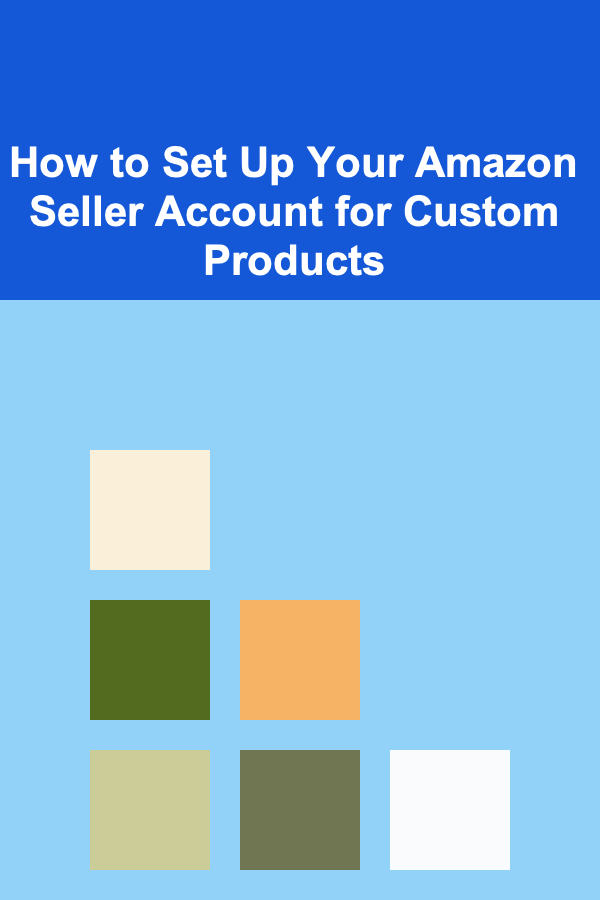
How to Set Up Your Amazon Seller Account for Custom Products
ebook include PDF & Audio bundle (Micro Guide)
$12.99$9.99
Limited Time Offer! Order within the next:

Selling custom products on Amazon is a great way to reach a global audience, tap into the platform's vast infrastructure, and scale your business. However, before you can start selling custom products, you need to set up your Amazon Seller Account and optimize it for success. In this actionable guide, we'll walk you through each step of the process, from creating your account to setting up your custom products for sale, and offer some insider tips to ensure you hit the ground running.
Step 1: Decide Which Amazon Seller Plan Suits You
Before you sign up for an Amazon Seller Account, it's essential to understand the different selling plans available. Amazon offers two primary plans: Individual and Professional.
- Individual Plan: This plan charges a fee of $0.99 per item sold, but there are no monthly subscription fees. It's ideal for new sellers or those who plan to sell fewer than 40 items per month.
- Professional Plan: This plan has a flat monthly fee of $39.99 but doesn't charge the per-item fee. It's designed for sellers who intend to sell more than 40 items per month or are looking for advanced features and scalability.
For custom products, the Professional Plan is typically the better choice, as it provides access to more advanced tools like advertising, bulk listings, and better reporting, which can significantly benefit your business.
Step 2: Register Your Amazon Seller Account
Once you've decided on a plan, the next step is to register your Amazon Seller Account. Here's how:
- Visit Amazon Seller Central : Go to Amazon Seller Central and click on "Register now."
- Provide Your Business Information: You'll need to provide basic details such as your business name, address, and tax identification number (TIN). If you're registering as an individual, you can use your personal details, but for a professional business, you'll need to provide your business information.
- Set Up Payment Information: Enter your bank account information, which will be used for receiving payments from Amazon once you start selling.
- Provide Your Identity Information: Amazon requires you to verify your identity. This may involve submitting a copy of your government-issued ID and utility bills or business documentation.
- Set Up Two-Step Authentication: To protect your account, Amazon will ask you to set up two-step authentication. This is an extra layer of security that ensures only you can access your account.
Step 3: Set Up Your Seller Profile and Brand
Your seller profile is the first impression customers will get of your business. It's crucial to make it clear, professional, and appealing. Here's what to include:
- Business Name and Logo: Choose a memorable business name that reflects your brand, and upload a professional logo. A strong, recognizable brand will help set you apart from competitors.
- Business Information: Fill out the "About Seller" section in your profile. Explain who you are, what you sell, and why customers should trust your custom products. Be clear and transparent.
- Shipping Options : Set up your shipping methods. You can use Fulfillment by Amazon (FBA) for inventory storage, shipping, and customer service, or Fulfillment by Merchant (FBM), where you handle these tasks yourself. For custom products, using FBA can simplify operations but may not be the best option for certain types of custom or made-to-order items.
- Store Policies: Be sure to clarify your return policy, shipping timelines, and customer service protocols. Since you're selling custom products, providing clear communication on these aspects is even more important.
Step 4: Create Listings for Custom Products
Now that your account is set up, it's time to create product listings for your custom items. This can be the trickiest part of the process, but it's crucial to make sure your listings are optimized to stand out and convert visitors into buyers.
- Product Title: Craft a concise and keyword-rich product title that clearly describes your custom product. Use relevant keywords that people are likely to search for when looking for your type of product. For instance, if you're selling custom T-shirts, a title like "Personalized Custom T-Shirt for Men - Customizable Text & Design - Perfect Gift" will likely perform better.
- Product Description: Write an engaging and informative product description. This is your opportunity to highlight what makes your custom products special and why customers should choose you. Make sure to focus on key benefits and features, such as quality, uniqueness, and customization options.
- Product Images: High-quality product images are essential for selling custom products. Use clear, well-lit photos that show off your product from multiple angles. If your product is customizable, consider including mockups or examples of previous designs to give customers a better understanding of what they can expect.
- Product Variations: For custom products, you may want to offer variations (e.g., size, color, or style). Amazon allows you to set up product variations within your listings. Be sure to provide all available customization options so customers can make informed decisions.
- Pricing: Set a competitive price for your custom products. While pricing can vary based on the complexity of customization, be sure to account for both material and labor costs. You may also need to include shipping costs if you're using FBM, whereas FBA will handle shipping fees for you.
Step 5: Optimize for Search with Keywords
To ensure your custom products appear in relevant search results, you need to optimize your listings for Amazon's search engine, A9. Use the following strategies to improve your search ranking:
- Keyword Research : Use tools like Amazon Keyword Tool or Helium 10 to find relevant keywords that potential customers might use to search for custom products like yours. For example, if you're selling custom mugs, you might target keywords like "personalized mug," "custom coffee mug," or "gift mug with name."
- Backend Keywords: Don't forget to include backend keywords when setting up your listing. These are keywords that don't appear in the front-end description but help Amazon categorize your product. These can include alternative spellings, regional terms, and other synonyms.
- Optimize Bullet Points: Your bullet points should highlight the key features and benefits of your custom products. Use clear, concise language to tell customers why your products are worth purchasing, making sure to integrate your primary keywords naturally.
Step 6: Set Up Customization Options
Selling custom products requires an extra level of setup for personalization. There are several ways to handle this:
- Product Customization Fields: Amazon allows sellers to add customizable options directly to the product listing page. You can include options such as text fields for engraving, drop-down menus for color selection, or upload buttons for customers to submit their artwork. Make sure these fields are clearly labeled and easy to use.
- Third-Party Tools: If your customization requires more complex options or design tools, you can integrate third-party solutions. Some companies provide software that lets customers see live previews of their customizations before purchase. While Amazon doesn't allow full-fledged design tools within the platform, you can direct customers to external websites or upload custom templates for them to download.
Step 7: Launch and Promote Your Custom Products
Once your listings are set up, it's time to promote your custom products to potential buyers. Here are a few strategies to consider:
- Amazon Advertising : Utilize Amazon's advertising tools like Sponsored Products or Sponsored Brands to increase visibility for your listings. Tailor your ad campaigns to target specific customer segments or interests.
- Social Media Marketing: Promote your custom products on social media platforms like Instagram, Facebook, and Pinterest. Post behind-the-scenes content, customer testimonials, and examples of your work.
- Influencer Marketing: Partner with influencers or bloggers in your niche to promote your products. Custom products are often highly shareable, making them a perfect fit for influencer campaigns.
- Discounts and Deals: Consider offering introductory discounts or flash sales to attract early buyers. Promotions like "Buy One, Get One" or time-limited discounts can create a sense of urgency.
Step 8: Provide Exceptional Customer Service
Customer service is critical when selling custom products. Since customers are purchasing personalized items, they expect excellent service. Be prompt in answering questions, provide clear instructions for customization, and offer a hassle-free return or exchange policy.
Conclusion
Setting up an Amazon Seller Account for custom products can be an exciting way to turn your creative skills into a thriving business. By following this actionable guide, you'll have a comprehensive plan to create optimized listings, attract the right customers, and set up your account for long-term success. Make sure to continually analyze your performance, adjust your strategies, and improve your offerings to stay competitive in the ever-changing world of eCommerce.

How to Create a Baby or Nursery Inventory
Read More
How To Introduce Basic Anatomy Through Play
Read More
How to Manage Pet Furniture and Bedding at Home
Read More
How to Sanitize Your Kitchen and Avoid Cross-Contamination
Read More
How to Utilize Voice Cloning Software for Profit
Read More
10 Tips for Maintaining Peak Physical Fitness as a Snowboard Instructor
Read MoreOther Products

How to Create a Baby or Nursery Inventory
Read More
How To Introduce Basic Anatomy Through Play
Read More
How to Manage Pet Furniture and Bedding at Home
Read More
How to Sanitize Your Kitchen and Avoid Cross-Contamination
Read More
How to Utilize Voice Cloning Software for Profit
Read More